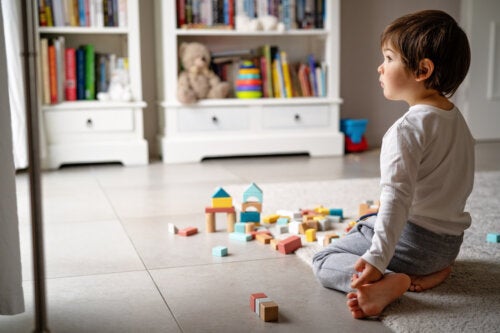Language Problems in Children Born During the Covid-19 Pandemic


Written and verified by the psychologist Elena Sanz Martín
Speech acquisition is one of the major milestones of childhood. It’s part of children’s ability to communicate, understand others, and make themselves understood. A delay in its onset can lead to social and academic complications. That’s why both parents and the medical community have raised the alarm regarding language problems in children born during the Covid-19 pandemic.
The truth is that language disorders are present in approximately 6% of preschool and school-aged children (Nieto, 2014). However, the pandemic brought a series of particular conditions that could influence those children whose critical stage of speech acquisition coincided with the pandemic. But what evidence do we have on this and what can we do?

What are language problems and how did the pandemic influence them?
Language problems don’t affect only speech. In fact, they can affect expression (verbal or written), comprehension, and the correct use of elements such as phonology or syntax.
In the latest version of the Diagnostic and Statistical Manual of Mental Disorders (2022), language problems are grouped under neurodevelopmental disorders. This is because they share a number of common genetic factors and neurological impairments.
However, these disorders are multi-causal, and the environment in which the child is inserted also exerts an important influence. In particular, the pandemic context generated by Covid-19 brought certain restrictions to communication and socialization.
As suggested by Dr. Gemma Ochando, a pediatrician at La Salud Hospital in Spain, confinement, the widespread use of masks, and increased social distancing brought a series of disadvantages in the development of language in children.
Some of the disadvantages are:
- Children’s neurosensory stimulation and social interactions were restricted to their nuclear family.
- The use of masks complicated the recognition of facial expressions and nonverbal language.
- Masks also made it difficult for them to hear verbal sounds clearly and correctly and hindered their ability to understand and imitate them.
- In a pandemic context, common social interaction patterns included keeping their distance, not touching, and avoiding approaching others. And this is what the infant mind assimilated as normal and appropriate.
- Children’s contact with their peers was also restricted. Playing in parks, squares, or streets with other children, or even going to school, wasn’t an option for some time. This meant deprivation of important stimuli and difficulty in learning by imitation.
Language problems in children born during the Covid-19 pandemic
Despite all of the above, there are no conclusive data pointing to an increase in language problems in children born during the Covid-19 pandemic. But there is some worrying data.
For example, a study published in the journal Frontiers in Pediatrics suggests that living through the Covid-19 pandemic is associated with an increased risk of delayed language development in first-born children.
In addition, a systematic review published in JAMA Network Open suggests that, although overall neurodevelopment wasn’t affected, living the first year of life in the context of the pandemic influenced the risk of communication delay in children.
These language impairments may include problems speaking, writing, or communicating through gestures. In addition to difficulties in following instructions, poor vocabulary, and poor willingness to speak.
As a result of these symptoms, children may have problems in school and academic performance, as well as socialization (Tomblin et al., 2003). As a result, they may experience great frustration and even damage to their self-esteem.
Furthermore, if these difficulties aren’t addressed and remain unresolved beyond the age of 5 years, there’s an increased risk that they’ll continue to occur into adolescence.

What to do about language problems in children born during the Covid-19 pandemic?
The detection of language problems in children born during the Covid-19 pandemic hasn’t been straightforward. This is due to difficult access to health services, as well as the general under-diagnosis that occurs with these disorders and confusion with other diagnoses such as autism spectrum disorder (ASD).
Despite this, in the face of any doubt or suspicion on the part of parents or health professionals, it’s important to take action to help the child. As suggested in an article published in Revista Médica Clínica Las Condes, it’s positive to create an optimal environment of stimulation and communication for children.
This can be achieved, for example, by singing songs, telling stories, establishing eye contact when talking to them, encouraging reading, or restricting the use of screens.
Part of the consequences of the pandemic
Ultimately, the pandemic context could affect children’s lives not only by causing stress, anxiety, or depression, but also by impairing the development of language and communication in little ones.
Living these restrictions during a critical stage of growth deprived them of certain necessary stimuli. For the same reason, if any difficulty is detected in this regard, it’s essential to seek professional guidance to receive proper evaluation and diagnosis and initiate early intervention.
Speech acquisition is one of the major milestones of childhood. It’s part of children’s ability to communicate, understand others, and make themselves understood. A delay in its onset can lead to social and academic complications. That’s why both parents and the medical community have raised the alarm regarding language problems in children born during the Covid-19 pandemic.
The truth is that language disorders are present in approximately 6% of preschool and school-aged children (Nieto, 2014). However, the pandemic brought a series of particular conditions that could influence those children whose critical stage of speech acquisition coincided with the pandemic. But what evidence do we have on this and what can we do?

What are language problems and how did the pandemic influence them?
Language problems don’t affect only speech. In fact, they can affect expression (verbal or written), comprehension, and the correct use of elements such as phonology or syntax.
In the latest version of the Diagnostic and Statistical Manual of Mental Disorders (2022), language problems are grouped under neurodevelopmental disorders. This is because they share a number of common genetic factors and neurological impairments.
However, these disorders are multi-causal, and the environment in which the child is inserted also exerts an important influence. In particular, the pandemic context generated by Covid-19 brought certain restrictions to communication and socialization.
As suggested by Dr. Gemma Ochando, a pediatrician at La Salud Hospital in Spain, confinement, the widespread use of masks, and increased social distancing brought a series of disadvantages in the development of language in children.
Some of the disadvantages are:
- Children’s neurosensory stimulation and social interactions were restricted to their nuclear family.
- The use of masks complicated the recognition of facial expressions and nonverbal language.
- Masks also made it difficult for them to hear verbal sounds clearly and correctly and hindered their ability to understand and imitate them.
- In a pandemic context, common social interaction patterns included keeping their distance, not touching, and avoiding approaching others. And this is what the infant mind assimilated as normal and appropriate.
- Children’s contact with their peers was also restricted. Playing in parks, squares, or streets with other children, or even going to school, wasn’t an option for some time. This meant deprivation of important stimuli and difficulty in learning by imitation.
Language problems in children born during the Covid-19 pandemic
Despite all of the above, there are no conclusive data pointing to an increase in language problems in children born during the Covid-19 pandemic. But there is some worrying data.
For example, a study published in the journal Frontiers in Pediatrics suggests that living through the Covid-19 pandemic is associated with an increased risk of delayed language development in first-born children.
In addition, a systematic review published in JAMA Network Open suggests that, although overall neurodevelopment wasn’t affected, living the first year of life in the context of the pandemic influenced the risk of communication delay in children.
These language impairments may include problems speaking, writing, or communicating through gestures. In addition to difficulties in following instructions, poor vocabulary, and poor willingness to speak.
As a result of these symptoms, children may have problems in school and academic performance, as well as socialization (Tomblin et al., 2003). As a result, they may experience great frustration and even damage to their self-esteem.
Furthermore, if these difficulties aren’t addressed and remain unresolved beyond the age of 5 years, there’s an increased risk that they’ll continue to occur into adolescence.

What to do about language problems in children born during the Covid-19 pandemic?
The detection of language problems in children born during the Covid-19 pandemic hasn’t been straightforward. This is due to difficult access to health services, as well as the general under-diagnosis that occurs with these disorders and confusion with other diagnoses such as autism spectrum disorder (ASD).
Despite this, in the face of any doubt or suspicion on the part of parents or health professionals, it’s important to take action to help the child. As suggested in an article published in Revista Médica Clínica Las Condes, it’s positive to create an optimal environment of stimulation and communication for children.
This can be achieved, for example, by singing songs, telling stories, establishing eye contact when talking to them, encouraging reading, or restricting the use of screens.
Part of the consequences of the pandemic
Ultimately, the pandemic context could affect children’s lives not only by causing stress, anxiety, or depression, but also by impairing the development of language and communication in little ones.
Living these restrictions during a critical stage of growth deprived them of certain necessary stimuli. For the same reason, if any difficulty is detected in this regard, it’s essential to seek professional guidance to receive proper evaluation and diagnosis and initiate early intervention.
All cited sources were thoroughly reviewed by our team to ensure their quality, reliability, currency, and validity. The bibliography of this article was considered reliable and of academic or scientific accuracy.
- Álvarez, D., & Barragán, E. (2022). A propósito de la pandemia COVID-19: hablemos con los padres con respecto a los trastornos del desarrollo del lenguaje. Revista Médica Clínica Las Condes, (33), 5. https://www.ncbi.nlm.nih.gov/pmc/articles/PMC9490832/
- American Psychiatric Association (2022) The Diagnostic and Statistical Manual of Mental Disorders, 5th Ed., Text Revision: DSM-5-TR. American Psychiatric Association Publishing.
- Hessami K, Norooznezhad AH, Monteiro S, et al. COVID-19 Pandemic and Infant Neurodevelopmental Impairment: A Systematic Review and Meta-analysis. JAMA Netw Open. 2022;5(10):e2238941. https://jamanetwork.com/journals/jamanetworkopen/article-abstract/2797911
- Huang, P., Zhou, F., Guo, Y., Yuan, S., Lin, S., Lu, J., … & Qiu, X. (2021). Association between the COVID-19 pandemic and infant neurodevelopment: a comparison before and during COVID-19. Frontiers in pediatrics, 1087 https://www.frontiersin.org/articles/10.3389/fped.2021.662165/full
- Nieto, P. (2014). Prevalencia de los trastornos del lenguaje y su impacto en la familia. En Psicología de la familia: Estructuras y trastornos (pp. 151 – 158). CEU. https://www.researchgate.net/publication/271013825_Prevalencia_de_los_trastornos_del_lenguaje_y_su_impacto_en_la_familia
- Tomblin J.B., Zhang X., Buckwalter P., O’Brien M. (2003) The stability of primary language disorder: four years after kindergarten diagnosis. Journal of Speech Language and Hearing Research. 2003;46(6):1283–1296 https://pubmed.ncbi.nlm.nih.gov/14700355/
This text is provided for informational purposes only and does not replace consultation with a professional. If in doubt, consult your specialist.








